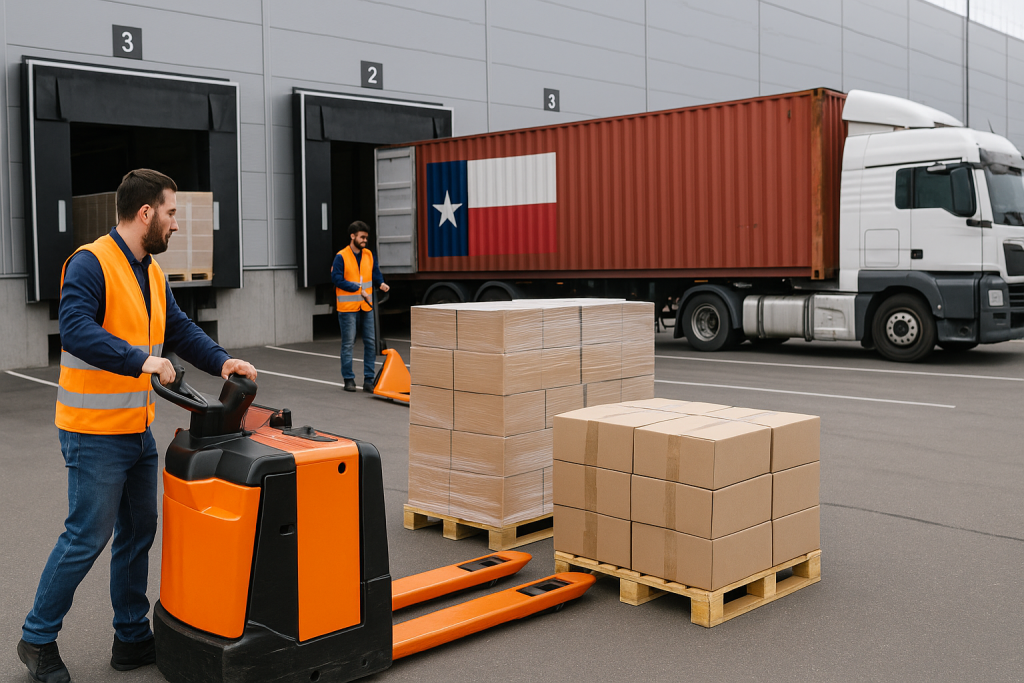By Martin Vassilev / 17 Sep, 2025
Cross-docking has become one of the most effective logistics strategies for companies seeking to optimize delivery speed and reduce operational costs. In regions like Ontario and Texas, where trade volumes and transportation networks are extensive, cross-dock solutions are increasingly crucial for businesses navigating the fast-paced demands of e-commerce, retail, and international trade. This article explores how cross-docking works, why Ontario and Texas are uniquely positioned to benefit, and how businesses can leverage these solutions to maximize efficiency.
Cross-docking is a logistics practice where goods are unloaded directly from inbound transportation (such as trucks or containers) and loaded onto outbound vehicles with little or no storage in between. Unlike traditional warehousing, where inventory may sit idle for days or weeks, cross-docking minimizes handling, reduces inventory holding costs, and accelerates order fulfillment.
For businesses managing high-volume or time-sensitive products—such as perishable goods, consumer electronics, and e-commerce orders—this model ensures faster transit and lower costs. ByExpress explains cross-docking in detail and highlights how companies can adopt it to streamline operations.
Ontario sits at the heart of Canada’s trade infrastructure. With proximity to the U.S. border and access to major highways, airports, and railways, Ontario serves as a critical hub for both domestic and cross-border logistics. Toronto, Ottawa, and Windsor all support large volumes of freight that require fast turnaround.
Businesses in Ontario are increasingly turning to cross-dock strategies to manage e-commerce surges and international trade. Leveraging local logistics services in Ottawa allows companies to shorten lead times and better serve Canadian and U.S. markets simultaneously.
Warehousing costs in Ontario are rising due to limited space and high demand. Cross-docking offers an alternative by reducing the need for long-term storage. Companies can ship goods directly to customers or retail locations without the burden of large warehouses, improving profitability.
Texas is a logistics powerhouse, thanks to its border with Mexico, major Gulf Coast ports, and expansive highway networks. The state handles enormous volumes of imports and exports, particularly in industries like automotive, energy, and consumer goods. Cross-dock solutions in Texas enable companies to process goods more efficiently and quickly reroute them to destinations across North America.
With cities like Dallas, Houston, and San Antonio driving both domestic and cross-border trade, Texas warehouses are under constant pressure to move products rapidly. Cross-docking reduces bottlenecks, supports faster last-mile delivery, and cuts unnecessary costs associated with warehousing.
For example, implementing fast fulfillment strategies in Texas allows businesses to compete with giants like Amazon, ensuring customers receive products within one to two days.
Cross-docking eliminates unnecessary storage time, moving goods seamlessly from inbound to outbound vehicles. This significantly improves delivery speed, a critical factor for businesses competing in e-commerce and retail markets.
By reducing warehousing expenses, labor costs, and handling time, companies can allocate resources more effectively. As ByExpress outlines in warehousing cost strategies, minimizing inventory storage is one of the most effective ways to control logistics expenses.
Fewer touchpoints in the supply chain mean reduced opportunities for product damage. This is particularly important for fragile goods like electronics, pharmaceuticals, and perishables.
Cross-docking aligns with broader strategies of supply chain optimization, ensuring smoother movement of goods and stronger coordination across logistics partners.
Fast-moving consumer goods require quick delivery and minimal delays. Cross-docking helps businesses meet customer expectations for same-day and next-day shipping.
Both Ontario and Texas are major automotive hubs. Cross-docking enables just-in-time delivery of parts, reducing the need for large inventory storage and supporting efficient assembly operations.
Food and pharmaceutical industries benefit from reduced handling and faster transit, ensuring compliance with health and safety standards.

While cross-docking offers major advantages, it is not without challenges:
Infrastructure Investment: Facilities must be equipped with advanced sorting and loading systems. Companies can overcome this by partnering with experienced 3PL providers offering cross-dock services.
Coordination Complexity: Managing inbound and outbound schedules requires precise synchronization. Leveraging digital tools and AI-driven logistics systems ensures accurate coordination.
Scalability Concerns: During peak seasons, demand may outpace capacity. Flexible models such as on-demand warehousing allow companies to scale cross-docking capacity quickly.
Automation and Robotics: Automated sorting systems and robotic pallet movers will improve efficiency. See warehouse automation insights for how this is reshaping logistics.
Green Logistics: Sustainability initiatives will integrate eco-friendly practices, reducing waste and emissions in cross-dock operations.
Real-Time Tracking: Enhanced visibility through IoT and tracking tools will allow companies to monitor shipments at every stage.
According to the U.S. Department of Transportation, technology-driven solutions are critical to handling future logistics growth, and cross-docking will be at the center of this transformation.
For companies operating in Ontario and Texas, adopting cross-dock strategies is more than a cost-saving measure—it’s a competitive necessity. By integrating this approach, businesses can achieve:
Faster delivery speeds
Reduced warehousing costs
Greater supply chain resilience
Improved customer satisfaction
Companies that delay adopting cross-docking risk falling behind competitors who prioritize speed, efficiency, and customer expectations.
Cross-dock solutions in Ontario and Texas represent a powerful opportunity for businesses aiming to reduce delivery times and costs. These regions’ unique trade advantages, combined with the scalability of cross-docking, position them as leaders in North American logistics. By leveraging innovative strategies, automation, and expert logistics partners, companies can build supply chains that are not only faster and leaner but also more competitive in a global marketplace.
For tailored cross-dock and logistics solutions that help your business stay ahead, contact ByExpress today.

“Thanks to Byexpress all my shipping and fulfillment costs are in line now”

“All my issues were solved by Byexpress team that I had with pervious 3pl provider.”

“Thank you Byexpress team could not done it without you guys.”

“Their integration and customer service were the key for me”

“Outstanding delivery service! The package was well-packaged, and
the delivery team was professional and courteous”

“Great and knowledgeable team to work with.”

Thanks, guys, for reducing my shipping rates
Ottawa Office
2411 Holly Lane
Ottawa, ON, K1V 7P2
Toronto Office
13-280 West Beaver Creek Road Unit #136
Richmond Hill, ON, L4B 3Z1
Alexandria Office
173 Kenyon Street West
Alexandria, ON, K0C 1A0
Montreal Office
4388 Saint-Denis Street Unit #200
Montreal, QC, H2J 2L1
California Office
155 North Riverview Drive
Anaheim Hills, CA, 92808
Call Us
Toll-Free: 1-866-744-7122
Local : 613-739-3000
Email Us
Multilingual Services










